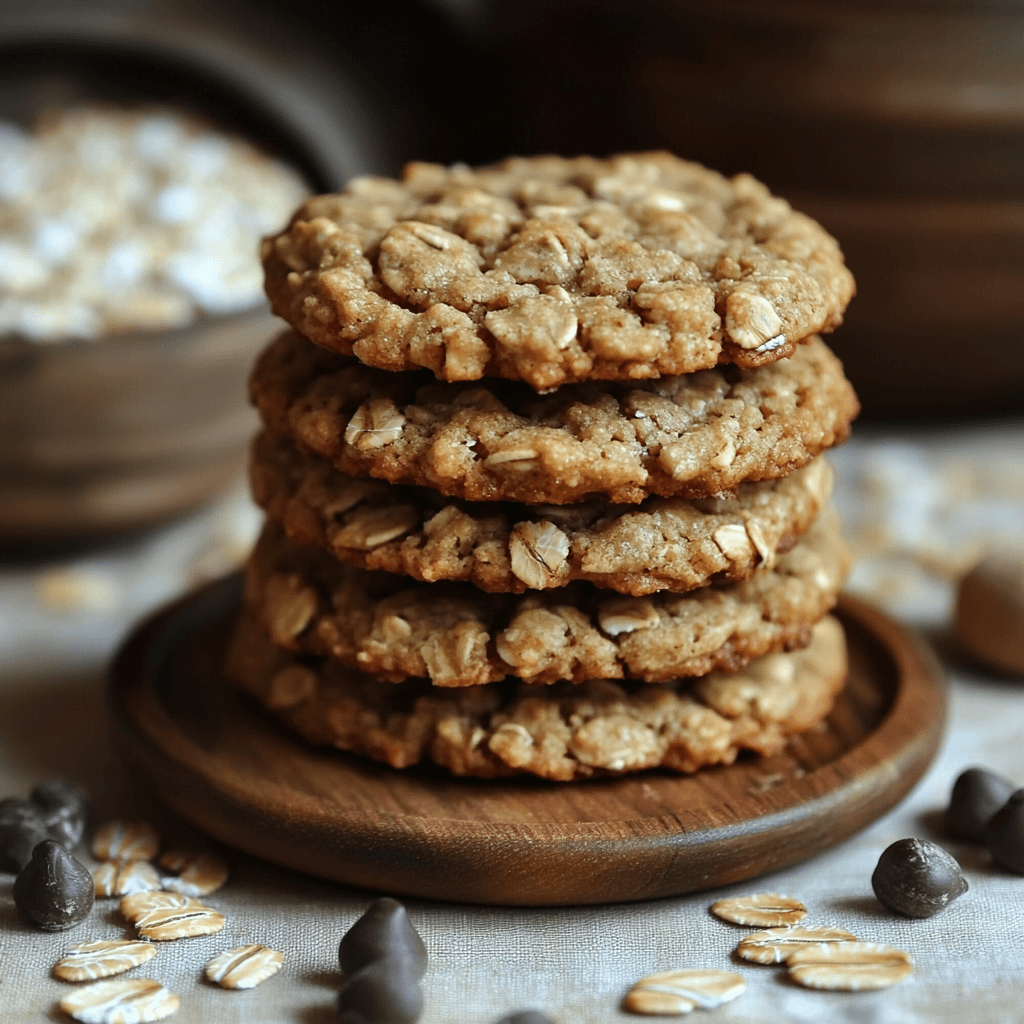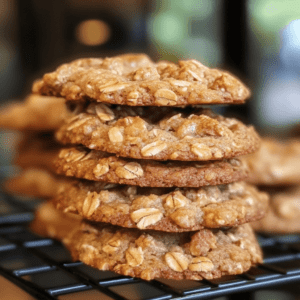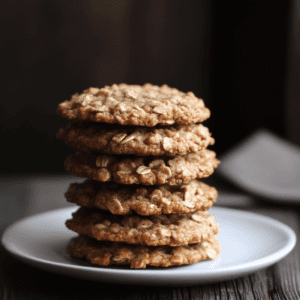Have you ever baked oatmeal cookies and wondered, Why are oatmeal cookies dry? It’s a common problem that can turn a delicious treat into a crumbly disappointment. Several factors, such as incorrect ingredient measurements, baking time, or mixing methods, can affect your cookie’s texture. Luckily, with a few simple adjustments, you can achieve soft, chewy oatmeal cookies every time. Let’s explore the causes and how to fix them!
Introduction
Oatmeal cookies are simple to make, but achieving the right texture can be tricky. A perfect oatmeal cookie is soft, chewy, and moist, yet some bakers often find that their cookies come out dry, tough, or crumbly. The good news is that this is a common issue, and once you understand the reasons behind it, you can easily fix the problem and bake perfect oatmeal cookies every time. This article will delve into the reasons why oatmeal cookies often turn out dry and provide practical solutions you can apply to your baking.
In the following sections, we will explore various aspects that can affect the texture and moisture of your oatmeal cookies, including ingredients, baking techniques, and even environmental factors.
Key Ingredients That Affect Moisture in Oatmeal Cookies
Before diving into troubleshooting and potential solutions for dry oatmeal cookies, it’s crucial to understand the key ingredients that influence moisture retention and texture. Different ingredients play unique roles in the final product, with some being more impactful than others when it comes to ensuring your cookies turn out soft, chewy, and moist.
The primary ingredients that affect the texture and moisture of oatmeal cookies include butter, sugar, eggs, oats, and flour. Butter contributes richness and moisture, while sugar helps with browning and texture. Eggs act as binding agents and add moisture to the dough. The type of oats you use—whether old-fashioned or quick oats—also affects the cookie’s final texture, with old-fashioned oats providing more chewiness. Additionally, the balance between flour and other wet ingredients is key to preventing dry cookies.
By understanding the role of each ingredient, you can better manage their proportions and ensure your oatmeal cookies come out just right. This knowledge will not only help you troubleshoot common baking issues but also empower you to make adjustments to achieve the perfect cookie every time.
The Importance of Fat in Your Oatmeal Cookies
Fat is one of the most important ingredients when it comes to moisture and tenderness in baking. In oatmeal cookies, butter or oil is usually used, and it serves a few important functions. Not only does it add flavor, but it also helps to create a tender, moist cookie. Fat helps to coat the flour molecules, preventing them from absorbing too much liquid, which can result in dry cookies. If your recipe uses a reduced-fat substitute or too little fat, you may find that your oatmeal cookies lack moisture and become dry and crumbly.
The type of fat you use also makes a difference. Butter is a popular choice for oatmeal cookies, as it adds richness and flavor. However, oil can be used for a slightly different texture. If you prefer your cookies to be more moist and soft, you may want to experiment with substituting butter with oil, which retains moisture better than butter.
How Eggs Contribute to Cookie Texture
Eggs play a significant role in baking, not only by helping bind ingredients together but also by contributing to the texture of the final product. When it comes to oatmeal cookies, eggs are essential because they help retain moisture and provide structure. Without enough eggs, your oatmeal cookies might be too dry and crumbly.
Eggs work by adding moisture and richness to the dough while also assisting in the development of the cookie’s structure. They help to bind the ingredients together, making the dough hold its shape during baking. Additionally, eggs contribute to the tenderness of the cookie by coating the flour particles, preventing them from absorbing too much liquid.
If your cookies are too dry, check your egg-to-flour ratio. Too few eggs can result in dry and crumbly cookies, while adding extra eggs can make them more cakey than chewy.
The Role of Oats in Cookie Texture
Oats are undeniably the star ingredient in oatmeal cookies, contributing to their signature texture, flavor, and nutritional value. The type of oats you choose can have a significant impact on the final outcome of your cookies, influencing everything from chewiness to flavor depth.
There are several types of oats available, including old-fashioned oats, quick oats, and instant oats, each of which behaves differently when baked. Old-fashioned oats, being thicker and less processed, provide a hearty, chewy texture that many people love in oatmeal cookies. Quick oats, on the other hand, are finer and absorb liquid faster, which can result in a softer and more uniform texture, but may not provide the same satisfying chew. Instant oats, due to their extensive processing, tend to break down more during mixing and baking, leading to a softer, sometimes mushy texture that may not hold up as well in cookies.
Choosing the right type of oats for your recipe is crucial to achieving the desired texture and flavor. By understanding how different oats behave, you can create oatmeal cookies that are perfectly tailored to your taste preferences.
Old-Fashioned Oats vs. Quick Oats
When it comes to oats, you may be tempted to use quick oats for convenience. However, this can lead to drier cookies. Quick oats are smaller and more processed than old-fashioned oats. They absorb moisture faster and tend to create a denser, more compact dough. This can result in a drier cookie that lacks the chewy texture typically associated with oatmeal cookies.
Old-fashioned oats, on the other hand, are thicker and less processed. They absorb moisture more slowly and retain their structure during baking. Using old-fashioned oats will help give your oatmeal cookies a chewy, soft texture, which is what most bakers desire. If you find that your cookies are consistently dry, try switching to old-fashioned oats instead of quick oats.
The Impact of Over-Processing Oats
Another important consideration is the processing of the oats. If you over-process your oats or grind them into a fine powder, you will essentially create flour, which will absorb more moisture and contribute to a drier cookie. For the best results, use rolled oats or thick-cut oats, as these will give your cookies the perfect balance of chewiness and moisture retention.
Measuring Ingredients Accurately
One of the most common reasons for dry oatmeal cookies is inaccurate measurements. When baking, precise measurements are key to achieving the correct texture and consistency. Too much or too little of a particular ingredient can throw off the entire recipe.
The Importance of Proper Flour Measurement
Flour is one of the main ingredients in oatmeal cookies, but too much flour can lead to dry cookies. If you scoop flour directly from the container, it can become compacted, resulting in more flour than you need. The proper way to measure flour is to spoon it into your measuring cup and level it off with a knife. This ensures that you are using the correct amount of flour, preventing your cookies from becoming too dry.
The Role of Sugar and Sweeteners
Sugar is another essential ingredient in oatmeal cookies. Not only does it add sweetness, but it also helps retain moisture. Sugar is hygroscopic, which means it attracts and holds onto moisture. This helps keep your oatmeal cookies from drying out. If you’re using sugar substitutes or artificial sweeteners, you may need to adjust your recipe to account for the lack of moisture-retaining properties.
Baking Time and Temperature
Even if you have the right ingredients, baking time and temperature can still affect the moisture content of your oatmeal cookies. Over-baking can lead to dry, hard cookies, so it’s important to keep a close eye on your baking time.
The Effect of Oven Temperature on Cookies
Oven temperature is a crucial factor when it comes to baking oatmeal cookies. If your oven is too hot, your cookies may cook too quickly on the outside, leaving the inside undercooked and dry. On the other hand, if your oven is too cool, the cookies may spread too much and become too thin.
The ideal oven temperature for oatmeal cookies is usually 350°F (175°C). This temperature allows the cookies to bake evenly without drying out. Be sure to preheat your oven before placing the cookies inside and use an oven thermometer to ensure your oven is at the correct temperature.
The Impact of Baking Time on Texture
Baking time is just as important as oven temperature. If you bake your cookies for too long, they will become dry and overcooked. Keep a close watch on your cookies as they bake and check them a few minutes before the recommended time is up. When the edges are golden brown and the centers are still soft, that’s the perfect time to remove them from the oven.
Over-Mixing Dough
Over-mixing your dough can result in dry, tough oatmeal cookies. The more you mix, the more gluten develops, which leads to a denser and drier texture.
How to Mix Oatmeal Cookie Dough Properly
When mixing oatmeal cookie dough, aim to combine the ingredients just until they are incorporated. Over-mixing can cause the dough to become too stiff, and the cookies will be tougher and drier. Once your wet and dry ingredients are mixed, stop stirring and prepare to scoop the dough onto your baking sheet.
The Role of Resting the Dough
Resting your dough is another step that can prevent dry cookies. Letting the dough rest for at least 30 minutes before baking allows the flour to hydrate and the fat to solidify. This will prevent the cookies from spreading too much during baking, helping them retain moisture and achieve a chewy texture.
Environmental Factors
Believe it or not, environmental factors such as humidity, temperature, and even altitude can influence the texture of your oatmeal cookies.
Baking at High Altitudes
If you live at a high altitude, you may notice that your cookies tend to be drier than those baked at sea level. At higher altitudes, the air pressure is lower, which can cause cookies to spread too much and dry out quickly. To fix this, you may need to adjust your recipe by adding a little more flour or sugar and reducing the baking time slightly.
The Effect of Weather on Cookie Texture
The weather can also affect your cookies. On humid days, your dough might become too soft, while dry, low-humidity days can cause your dough to absorb moisture from the air, making it drier. Adjusting the amount of flour and liquid in your recipe can help you adapt to different weather conditions and ensure your oatmeal cookies turn out just right.
Solutions to Prevent Dry Oatmeal Cookies
Now that we’ve covered the common causes of dry oatmeal cookies, it’s time to discuss some practical solutions that will help you create soft, chewy cookies every time.
Adjusting the Liquid Content
If your oatmeal cookies are too dry, try adding a little more liquid to the dough. You can use milk, water, or even a bit of yogurt to add moisture. Be careful not to add too much, as the dough can become too runny, which may cause the cookies to spread too much during baking.
Adding Moisture-Rich Ingredients
Incorporating moisture-rich ingredients into your oatmeal cookies can help prevent dryness. Consider adding ingredients like applesauce, mashed bananas, or yogurt to your cookie dough. These ingredients will add moisture and help create a soft, chewy texture. Additionally, they can add a unique flavor and improve the overall taste of your cookies.
Conclusion
Baking the perfect oatmeal cookies can be challenging, especially when they turn out dry. However, by understanding the key factors that affect cookie texture, including ingredients, baking time, and environmental conditions, you can create soft, chewy oatmeal cookies every time. By making small adjustments to your recipe, such as using old-fashioned oats, measuring ingredients accurately, and adjusting the baking time, you’ll never have to wonder again: Why are my oatmeal cookies always dry?
Final Tips for Perfect Oatmeal Cookies
- Use old-fashioned oats for a chewy texture.
- Measure your ingredients carefully, especially flour and sugar.
- Avoid over-mixing the dough, and let it rest before baking.
- Adjust your baking time and temperature to prevent over-baking.
With these tips in mind, your oatmeal cookies will be moist, tender, and full of flavor every time you bake them.
Related article:
Are quick oats or old-fashioned oats better for cookies?
Why Can’t You Use Instant Oats in Cookies?



